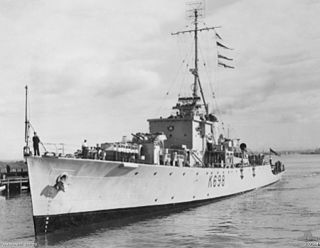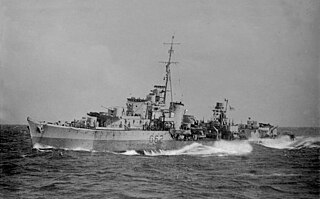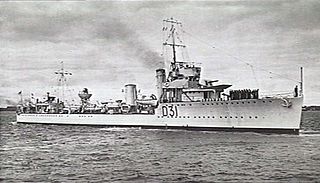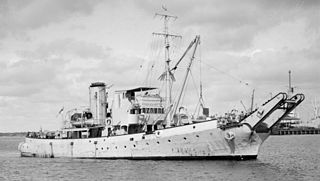Related Research Articles

Five ships of the Royal Australian Navy (RAN) have been named HMAS Sydney, after Sydney, the capital city of New South Wales.
Three ships of the Royal Australian Navy have been named HMAS Anzac, after the Australian and New Zealand Army Corps (ANZAC).

HMAS Burdekin (K376) was a River-class frigate that served the Royal Australian Navy (RAN) from 1944 to 1946. She was named for the Burdekin River in Queensland and was one of twelve River-class frigates built for the RAN during World War II.

HMAS Condamine (K698/F698), named for the Condamine River in Queensland, was a River-class frigate of the Royal Australian Navy (RAN). Commissioned in 1946, Condamine served in the Korean War. The ship was paid off in 1955, and sold for scrap in 1961.
Four ships of the Royal Australian Navy been named HMAS Parramatta, for the Parramatta River. The name comes from the Barramattagal people.
Three ships of the Royal Australian Navy (RAN) have been named HMAS Perth after Perth, the capital city of Western Australia.

HMAS Quadrant (G11/D11/F01), named for the navigational instrument, was a Q-class destroyer operated by the Royal Navy as HMS Quadrant (G67/D17) during World War II, and the Royal Australian Navy (RAN) from 1945 to 1957. The ship was built during the early 1940s as one of the War Emergency Programme destroyers, and entered service in 1942.

HMAS Quiberon (G81/D20/D281/F03) was a Q-class destroyer of the Royal Australian Navy (RAN). Although built for the Royal Navy and remaining British property until 1950, Quiberon was one of two Q-class destroyers commissioned into the RAN during World War II. She was passed into full RAN ownership in 1950, and converted into an anti-submarine frigate.

HMAS Quickmatch (G92/D21/D292/F04) was a Q-class destroyer operated by the Royal Australian Navy (RAN). Although commissioned into the RAN in 1942, the ship was initially the property of the Royal Navy. Quickmatch served with both the British Eastern Fleet and British Pacific Fleet during World War II. In the 1950s, the destroyer was converted into an anti-submarine frigate. In 1957, Quickmatch operated in support of Malaya during the Malayan Emergency. The ship remained in service until 1963, and after use as an accommodation ship, was sold for scrap in 1972.
Two ships of the Royal Australian Navy (RAN) have been named HMAS Vampire.
Two ships of the Royal Australian Navy (RAN) have been named HMAS Vendetta.

HMS Quality (G62/D18) was a Q-class destroyer built for the Royal Navy. Entering service in 1942, the destroyer served in several theatres of World War II. Following the war's conclusion, the ship was transferred to the Royal Australian Navy (RAN), commissioning as HMAS Quality (G62/D262) in late 1945. Unlike her sister ships, which were refitted as anti-submarine frigates, Quality was not modified, decommissioned after only 59 days of service, and was sold for scrap in 1958.

HMAS Platypus was a submarine depot ship and base ship operated by the Royal Australian Navy (RAN) between 1919 and 1946. Ordered prior to World War I to support the Australian submarines AE1 and AE2, Platypus was not completed until after both submarines had been lost, and she was commissioned into the Royal Navy from 1917 to 1919.

HMAS Stuart was a British Scott-class flotilla leader. The ship was built by Hawthorn Leslie and Company for the Royal Navy during World War I, and entered service at the end of 1918. The majority of the destroyer's British service was performed in the Mediterranean, and in 1933 she was transferred to the Royal Australian Navy. Although placed in reserve in 1938, Stuart was reactivated at the start of World War II to lead the Australian destroyer force, nicknamed the "Scrap Iron Flotilla" by German propagandists.

HMAS Stuart was one of six River-class destroyer escorts built for the Royal Australian Navy (RAN). The ship was laid down by the Cockatoo Docks and Engineering Company at Cockatoo Island Dockyard in 1959, and commissioned into the RAN in 1963.

HMAS Norman (G49/D16) was an N-class destroyer operated by the Royal Australian Navy (RAN) during World War II. Entering service in 1941, the ship was on loan from the Royal Navy.

HMAS Gascoyne (K354/F354/A276) was a River-class frigate that served in the Royal Australian Navy (RAN). Laid down in 1942 and commissioned in 1943, the frigate served during World War II, before being placed in reserve in 1946. Reactivated in 1959, Gascoyne was reclassified as a survey and research ship, a role she fulfilled until she was decommissioned again in 1966, and sold for scrap in 1972.

HMAS Voyager (D31/I31) was a W-class destroyer of the Royal Navy (RN) and Royal Australian Navy (RAN). Commissioned into the RN in 1918, the destroyer remained in RN service until 1933, when she was transferred to the RAN. Recommissioned, Voyager served in the Mediterranean and Pacific theatres of World War II until 23 September 1942, when she ran aground while trying to deliver troops to Timor. The ship was damaged by Japanese bombers while trying to refloat, then was scuttled by her crew.

HMAS Yarra, named for the Yarra River, was a River-class destroyer escort of the Royal Australian Navy (RAN). The antisubmarine warship operated from 1961 to 1985.

HMAS Kangaroo was a Bar-class boom defence vessel of the Royal Australian Navy (RAN). Although originally ordered as a boom vessel, Kangaroo was at one point to be built as the prototype for what became the Bathurst class corvettes, but reverted to the boom defence design before construction started. Launched in 1940, the ship spent most of World War II operating the anti-submarine net in Darwin. Kangaroo remained in service until 1955, and after several years as an accommodation ship, was sold for scrapping in 1967.
References
- ↑ "Navy Marks 109th Birthday With Historic Changes To Battle Honours". Royal Australian Navy. 1 March 2010. Archived from the original on 13 June 2011. Retrieved 23 December 2012.
- ↑ "Royal Australian Navy Ship/Unit Battle Honours" (PDF). Royal Australian Navy. 1 March 2010. Archived from the original (PDF) on 14 June 2011. Retrieved 23 December 2012.